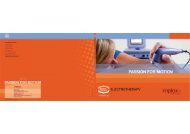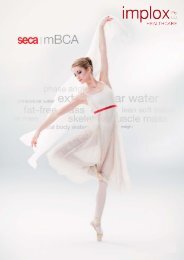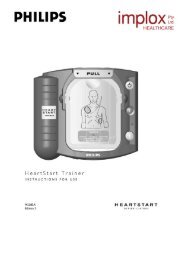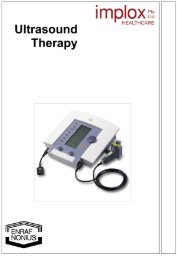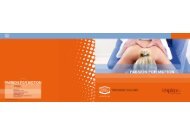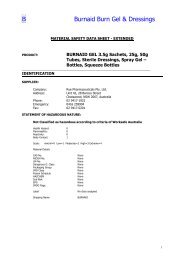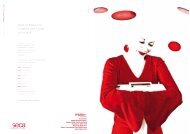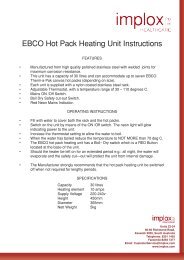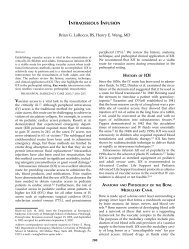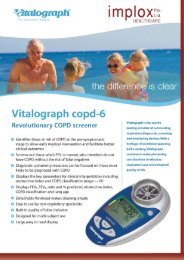Low and medium Frequency Electrotherapy - Implox
Low and medium Frequency Electrotherapy - Implox
Low and medium Frequency Electrotherapy - Implox
You also want an ePaper? Increase the reach of your titles
YUMPU automatically turns print PDFs into web optimized ePapers that Google loves.
2. Varying the frequency (the ‘<strong>Frequency</strong> Modulation’):<br />
Bernard was the first to use this method of preventing accommodation, in the form of the CP <strong>and</strong> LP currents. Here,<br />
there is a rhythmic alternation of 50 Hz <strong>and</strong> 100 Hz frequencies. The same principle is used in interferential therapy,<br />
in the form of ‘<strong>Frequency</strong> Modulation’ (Fig. 24).<br />
The following parameters are of importance:<br />
a. The width of the <strong>Frequency</strong> Modulation<br />
A ‘broad’ <strong>Frequency</strong> Modulation (i.e. a large frequency range) is better for preventing accommodation than a ‘narrow’<br />
<strong>Frequency</strong> Modulation (i.e. a small frequency range); the large changes in frequency with a broad <strong>Frequency</strong><br />
Modulation result in strongly varying sensations <strong>and</strong>/or contractions.<br />
b. The <strong>Frequency</strong> Modulation mode (<strong>Frequency</strong> Modulation variation or <strong>Frequency</strong> Modulation sweep)<br />
Depending on the equipment used, there are various ways of indicating the ratio between the base AMF <strong>and</strong> the<br />
<strong>Frequency</strong> Modulation (in seconds). Examples are: 1/1, 1/5/1/5, 6/6 <strong>and</strong> 1/30/1/30 s.<br />
<strong>Frequency</strong><br />
Modulation<br />
AMF (Hz)<br />
70<br />
20<br />
0<br />
6 12 18<br />
T (s.)<br />
Fig. 24,<br />
Example of <strong>Frequency</strong> Modulation.<br />
If the AMF is set at 20 Hz <strong>and</strong> the <strong>Frequency</strong> Modulation at 50 Hz, the current will scan through all frequencies<br />
between 20 Hz <strong>and</strong> 70 Hz.<br />
3. Setting a lower AMF.<br />
The foregoing can be summarized in the following basic rules.<br />
Taking accommodation into account, patients with acute conditions are treated with:<br />
• a relatively low amplitude;<br />
• a relatively high AMF;<br />
• a relatively broad <strong>Frequency</strong> Modulation;<br />
• a relatively gently changing <strong>Frequency</strong> Modulation program with a long duration (6/6 or 1/30/1/30 s’).<br />
Taking accommodation into account, patients with less acute conditions are treated with:<br />
• a relatively high amplitude;<br />
• a relatively low AMF;<br />
• a relatively narrow <strong>Frequency</strong> Modulation;<br />
• a relatively abrupt <strong>Frequency</strong> Modulation program with a short duration (1/1 s).<br />
3.5 TENS<br />
TENS (Transcutaneous Electrical Nerve Stimulation) is the application of electrodes to the skin with the aim of<br />
reducing pain by stimulating the thick afferent nerve fibres. In view of the fact that other current types such as<br />
diadynamic currents, 2-5 current <strong>and</strong> interferential currents also stimulate the nerves via the skin, the choice of the<br />
term TENS is somewhat unfortunate.<br />
In TENS there is generally an alternating current, characterized by a variable phase duration <strong>and</strong> a variable phase<br />
interval which can be used to vary the frequency. The phase duration is generally very short, varying from 10 to 250<br />
µs. Thus, the TENS current types make it possible to stimulate the nerve fibres selectively (see paragraph 2.3.1).<br />
The best known types of TENS application are Conventional TENS (high-frequency, low-intensity TENS) with a<br />
frequency between 80 <strong>and</strong> 100 Hz, <strong>and</strong> low-frequency, high-intensity TENS (‘acupuncture-like TENS’) with a<br />
frequency of less than 10 Hz. More recently other frequencies <strong>and</strong> current types (Burst TENS) have been used, partly<br />
due to the influence of the publications of Sjölund <strong>and</strong> Eriksson (27) .<br />
Enraf-Nonius supply several electrotherapy units that can be used to apply TENS current types (Fig. 25, 26 <strong>and</strong> 27).<br />
Lundeberg (20) has achieved excellent results with the use of an alternating square pulse in the treatment of wounds.<br />
This does not mean that the square pulse is unsuitable for other applications, but it does appear to have a specific<br />
application in wound healing. The application of TENS current types in wound healing is dealt with in more detail in<br />
Chapter 8.<br />
21



